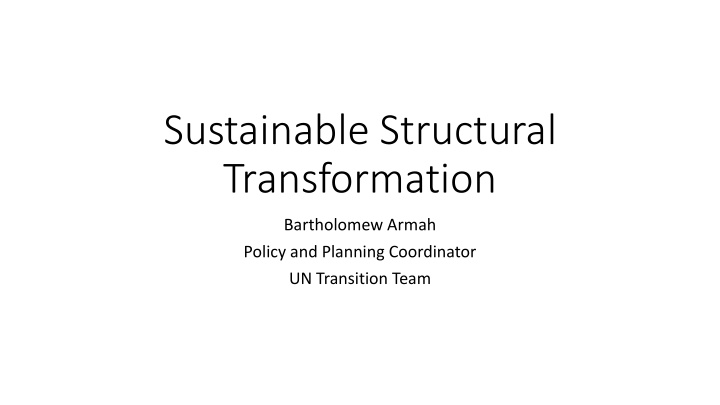



Sustainable Structural Transformation Bartholomew Armah Policy and Planning Coordinator UN Transition Team
Outline • Structural transformation in the context of sustainable development • The UN approach to structural transformation • Recent socio-economic and environmental trends and trade-offs in structural transformation • Policy sequencing and structural transformation
Structural Transformation and Sustainable development • Traditional definitions of ST have focused on productivity with little emphasis on inclusion and sustainability • Definitions emphasize : • A relative decline in the sectoral shares of low-productivity agriculture and low value-added extractive activities; • a relative increase in manufacturing and high-productivity services; • a decline in the relative share of agricultural employment in GDP; • increasing rural-to-urban migration that stimulates the process of urbanisation; • and the rise of a modern industrial and service economy. • In Africa the shift has been from agriculture to not necessarily high productivity services
Sustaining Structural Transformation – the new UN approach • Explicitly takes into account inclusion and environmental sustainability • Economic transformation comprises long lasting fundamental changes in the economy that raise the overall productivity level while ensuring adequate quantity and quality of employment, equitable distribution of income and wealth, and access to quality public services, and protection of and respect for environment • Addressing the social and environmental consequences of policies should not be viewed as an afterthought to the economic growth process.
Trade-offs • Few developed countries have been successful in simultaneously achieving rapid, green, and inclusive growth . • Some studies [e.g., Dastidar (2012)] found that where structural change is characterized by a transition from agriculture to industry, inequality did not increase in developing countries. • On the other hand, inequality was found to rise in developing countries experiencing an agriculture-service transformation. In the latter case, the increase in inequality rises with when initial levels of inequality exceed the average. • Studies [Qizilbash, 2010] find that countries that perform well in indicators of well-being and poverty had the highest levels of environmental degradation • Sweden and Denmark rank 39 th in Carbon Dioxide emissions
Territorial emissions in Metric tons of CO ₂ 10000 12000 2000 4000 6000 8000 0 1960 1962 1964 1966 1968 EU28 1970 1972 1974 China 1976 1978 1980 United States of America 1982 1984 1986 1988 1990 1992 1994 1996 India 1998 2000 2002 Indonesia 2004 2006 2008 2010 2012 2014 2016 2018
Positive growth trends in Africa 10 8 6 4 2 0 2000 2001 2002 2003 2004 2005 2006 2007 2008 2009 2010 2011 2012 2013 2014 2015 2016 2017 2018 2019 -2 -4 Advanced economies Emerging market and developing economies Sub-Saharan Africa World
But evidence of de-industrialization in Africa Employment in industry % of total Manufacturing value Added (% of GDP) 35 30 30 25 25 20 20 15 15 10 10 5 5 0 0 2007 2008 2009 2010 2011 2012 2013 2014 2015 2016 2007 2008 2009 2010 2011 2012 2013 2014 2015 2016 Sub-Saharan Africa East Asia & Pacific World Sub-Saharan Africa East Asia & Pacific World
And growth not associated with rising opportunities for decent work Vulnerable Employment % of Total Wage and salaried workers % of Total 70 80 60 70 60 50 50 40 40 30 30 20 20 10 10 0 0 2007 2008 2009 2010 2011 2012 2013 2014 2015 2016 2007 2008 2009 2010 2011 2012 2013 2014 2015 2016 Sub-Saharan Africa East Asia & Pacific World Sub-Saharan Africa East Asia & Pacific World
Perspectives on policy sequencing • How can we ensure that positive changes along social and environmental dimensions reinforce economic transformation?
Prioritizing social inclusion interventions catalyzes inclusive structural transformation in Africa Direct ST impact Economic Environmental Total Effect Social 0.02 2.79 -2.37 0.44 Direct ST impact Economic Social Total Environmental -0.19 1.71 -1.25 0.27 Direct Social Environmental Total Economic 1.09 -1.75 0.81 0.15
Parting thoughts • Sequencing matters : Structural transformation measures should be informed by efforts to assess the likely effects of policy interactions on inclusion and sustainable development • Reflect the environmental dimension in indicators of decent work: • The Decent Work Agenda currently combines access to full and productive employment with rights at work, social protection and the promotion of social dialogue • But decent work should also be about the environment impacts of ones occupation • Domestic job creation may not always be consistent with free trade in the short run
Ongoing projects in Africa – glimpses of industrial development • Ethiopia’s flagship Hawassa Industrial Park is a 300-hectare industrial park, which is focused on textile and garment production and is expected to create about 60,000 jobs when fully operational. • The park has state-of-the-art infrastructure and facilities, which will be mostly powered by renewable energy, making it the first sustainable textile and apparel industrial park in Africa. • The Derba-Midroc Cement Project a $350 million integrated cement plant project which is uses local limestone deposit of 165 million tons • The government banned cement imports on 27 March 2012 to protect upcoming domestic cement production. • It is helping to meet 100% of the country’s cement needs and exporting to nearby countries. • The plant resulted in a 75% drop in the price of cement and a reduction of cement import dependency. • The project created about 2,000 jobs during construction and presently employs 739 permanent workers of which 17% are females.
Recommend
More recommend